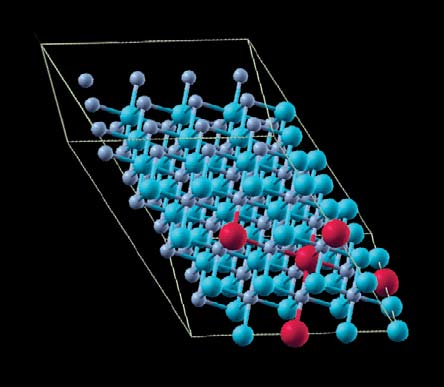The computer visualization depicts the atomic structure of the rocksalt structure semiconductor scandium nitride, doped with 8 percent manganese. The manganese is shown in red, scandium in light blue and nitrogen in silver.
Spintronics – short for spin-based electronics – may soon provide tinier, faster and more robust components for small electronic devices and computers. The spintronics approach stores electronic data through magnetic properties caused by the spinning of electrons, in addition to the fundamental electrical charge of electrons that is used by more conventional computers. The spin charge is assigned a value of “up” or “down” and, like the electrical charge, can be encoded with binary data.
“In semiconductors, one can possibly have far more detailed control over both the number of active electrons and their spin orientation in a device,” said Walter Lambrecht, Ph.D., professor of physics at Case Western Reserve University. “The problem is to find magnetic semiconductors that retain these distinct magnetic properties above room temperature.”
These specialized semiconductors are created through a process called doping: manufacturing into the semiconductor small amounts of transition metals or rare-earth elements, which possess distinctive electronic properties. While most work in this field requires a small percentage of the dopant, gadolinium-doped gallium nitride has been found during experiments to exhibit the desired magnetic properties even for part-permillion levels.
“We are accessing the computational resources of the Ohio Supercomputer Center to perform calculations of various possible irregularities in the atomic arrangement and studying their interaction with gadolinium in gallium-nitride to unravel the origin of this mysterious source of magnetism,” said Dr. Lambrecht.
--
Project lead: Walter L. Lambrecht, Ph.D., Case Western Reserve University
Research title: Muffin-tin orbital based first-principles calculations
Funding sources: Office of Naval Research & the Army Research Office
